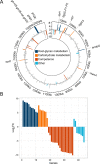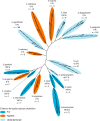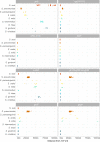Host-glycan metabolism is regulated by a species-conserved two-component system in Streptococcus pneumoniae
- PMID: 32130269
- PMCID: PMC7075642
- DOI: 10.1371/journal.ppat.1008332
Host-glycan metabolism is regulated by a species-conserved two-component system in Streptococcus pneumoniae
Abstract
Pathogens of the Streptococcus genus inhabit many different environmental niches during the course of an infection in a human host and the bacteria must adjust their metabolism according to available nutrients. Despite their lack of the citric-acid cycle, some streptococci proliferate in niches devoid of a readily available carbohydrate source. Instead they rely on carbohydrate scavenging for energy acquisition, which are obtained from the host. Here we discover a two-component system (TCS07) of Streptococcus pneumoniae that responds to glycoconjugated structures on proteins present on the host cells. Using next-generation RNA sequencing we find that the uncharacterized TCS07 regulon encodes proteins important for host-glycan processing and transporters of the released glycans, as well as intracellular carbohydrate catabolizing enzymes. We find that a functional TCS07 allele is required for growth on the glycoconjugated model protein fetuin. Consistently, we see a TCS07-dependent activation of the glycan degradation pathway. Thus, we pinpoint the molecular constituents responsible for sensing host derived glycans and link this to the induction of the proteins necessary for glycan degradation. Furthermore, we connect the TCS07 regulon to virulence in a mouse model, thereby establishing that host-derived glycan-metabolism is important for infection in vivo. Finally, a comparative phylogenomic analysis of strains from the Streptococcus genus reveal that TCS07 and most of its regulon is specifically conserved in species that utilize host-glycans for growth.
Conflict of interest statement
The authors have declared that no competing interests exist.
Figures









Similar articles
-
Pn-AqpC-Mediated Fermentation Pattern Coordination with the Two-Component System 07 Regulates Host N-Glycan Degradation of Streptococcus pneumoniae.Microbiol Spectr. 2022 Oct 26;10(5):e0249622. doi: 10.1128/spectrum.02496-22. Epub 2022 Sep 15. Microbiol Spectr. 2022. PMID: 36106896 Free PMC article.
-
Molecular Characterization of N-glycan Degradation and Transport in Streptococcus pneumoniae and Its Contribution to Virulence.PLoS Pathog. 2017 Jan 5;13(1):e1006090. doi: 10.1371/journal.ppat.1006090. eCollection 2017 Jan. PLoS Pathog. 2017. PMID: 28056108 Free PMC article.
-
Glycan-metabolizing enzymes in microbe-host interactions: the Streptococcus pneumoniae paradigm.FEBS Lett. 2018 Dec;592(23):3865-3897. doi: 10.1002/1873-3468.13045. Epub 2018 Apr 19. FEBS Lett. 2018. PMID: 29608212 Review.
-
Surface Proteins and Pneumolysin of Encapsulated and Nonencapsulated Streptococcus pneumoniae Mediate Virulence in a Chinchilla Model of Otitis Media.Front Cell Infect Microbiol. 2016 May 18;6:55. doi: 10.3389/fcimb.2016.00055. eCollection 2016. Front Cell Infect Microbiol. 2016. PMID: 27242973 Free PMC article.
-
Streptococcus pneumoniae two-component regulatory systems: The interplay of the pneumococcus with its environment.Int J Med Microbiol. 2018 Aug;308(6):722-737. doi: 10.1016/j.ijmm.2017.11.012. Epub 2017 Nov 26. Int J Med Microbiol. 2018. PMID: 29221986 Review.
Cited by
-
Pivotal Roles for Ribonucleases in Streptococcus pneumoniae Pathogenesis.mBio. 2021 Oct 26;12(5):e0238521. doi: 10.1128/mBio.02385-21. Epub 2021 Sep 21. mBio. 2021. PMID: 34544281 Free PMC article.
-
Role of EmaSR in Ethanol Metabolism by Acinetobacter baumannii.Int J Mol Sci. 2022 Oct 20;23(20):12606. doi: 10.3390/ijms232012606. Int J Mol Sci. 2022. PMID: 36293461 Free PMC article.
-
Multi-omics driven biomarker discovery and pathological insights into Pseudomonas aeruginosa pneumonia.BMC Infect Dis. 2025 May 24;25(1):745. doi: 10.1186/s12879-025-11119-7. BMC Infect Dis. 2025. PMID: 40413399 Free PMC article.
-
Carbon source-dependent capsule thickness regulation in Streptococcus pneumoniae.Front Cell Infect Microbiol. 2023 Nov 29;13:1279119. doi: 10.3389/fcimb.2023.1279119. eCollection 2023. Front Cell Infect Microbiol. 2023. PMID: 38094742 Free PMC article.
-
A comprehensive analysis of pneumococcal two-component system regulatory networks.NAR Genom Bioinform. 2024 Apr 22;6(2):lqae039. doi: 10.1093/nargab/lqae039. eCollection 2024 Jun. NAR Genom Bioinform. 2024. PMID: 38650915 Free PMC article.
References
-
- Peterson SN, Sung CK, Cline R, Desai B V, Snesrud EC, Luo P, et al. Identification of competence pheromone responsive genes in Streptococcus pneumoniae by use of DNA microarrays. Mol Microbiol. 2004;51: 1051–70. Available: http://www.ncbi.nlm.nih.gov/pubmed/14763980 10.1046/j.1365-2958.2003.03907.x - DOI - PubMed
Publication types
MeSH terms
Substances
LinkOut - more resources
Full Text Sources
Medical
Molecular Biology Databases

